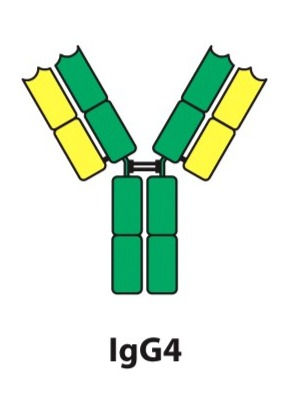
Protein Engineering
We tailor solutions to each project of each client.
AnproTech has devoted to the field of protein engineering for over a decade and established a series of comprehensive platforms to integrate various antibody engineering services. With the extensive experience, abundant industry knowledge and advanced technical skills, our scientists are fully confident in accomplishing even the most challenging antibody engineering project.
1.
Ig Class and Isotype Switching
The selection and characterization have been shown below.
AnproTech can take any parental antibody and perform class or isotype switching to investigate the effect of different Fc moiety on the activity of the antibody. This process usually involves taking the variable domains from antibody classes other than IgG (i.e. IgM, IgA, IgD or IgE) and linking to the desired IgG isotype 1-4. Antibodies can be configured with any additional constant region mutations that you require to tailor the properties of the antibody to your precise specification.
2.
Antibody Reformatting
The selection and characterization have been shown below.
AnproTech can reformat the variable region of an immunoglobulin into a variety of different fragments such as Fab, F(ab)’2, scFv, VHH, and minibodies, or can be combined with a second specificity to make bispecific antibodies.
3.
Protein Deimmunisation
Therapeutic proteins often have the undesirable potential of eliciting an unwanted immune response in patients. Clinical studies have shown that both human proteins (e.g. EPO, IFNα and IFNβ) and non-human proteins (e.g. staphylokinase) can induce immune responses ranging from neutralising antibodies to severe allergic reactions and even autoimmunity. Composite Protein™ and EpiScreen™ technology employed to reduce the immunogenicity of proteins have not always proved effective and occasionally have unintended consequences such as a reduction in yield due to manufacturing issues.
4.
Affinity Maturation
AnproTech uses phage display technology to increase the binding affinity of a starting antibody. A typical increase of 10 -100-fold can be achieved. The options of screening for potential immunogenicity and providing an antibody that avoids T cell epitopes can be added to an affinity maturation project. Our extensive experience of bioassay development enables us to routinely isolate antibodies with equivalent binding specificities to the original antibody and with picomolar binding affinities.
5.
Bioassays and Bioanalytics
AnproTech’s bioanalytics and bioassay services are designed to be there at any point in the drug development pathway to help you understand your molecule and its mechanism of action.
6.
Custom Projects
Antibody engineering projects come in all shapes and sizes with no two projects being the same. No matter what your engineering requirements, from generating chimeric antibodies to introducing cysteine residues in defined positions for conjugation purposes, we can help you with your project.
The IgG isotopes selection and their characteristics

IgG1 is the most commonly used immunoglobulin isotype in therapeutic monoclonal antibody development due to its intrinsically high stability and its natural ability to elicit complement activation (CDC) and effector-mediated cell killing by antibody-dependent cell-mediated cytotoxicity (ADCC).

IgG2 can naturally dimerise to become tetravalent, which may play a role in its natural functionality. IgG2 has evolved to have reduced ADCC and CDC functions compared to IgG1 and has been used in a small number of licensed therapeutic antibodies where effector functions are not required.

IgG3 has similar properties to IgG1 with regard to ADCC and CDC, although it has a reduced half-life compared to the other IgG isotypes.

IgG4 has very weak ADCC activity (comparable to IgG2) and virtually no CDC activity, which makes it the preferred choice for developing monoclonal antibodies for indications where only blocking of molecular interactions is required. IgG4 can be configured with, or without, the hinge stabilising S241P (Kabat numbering) mutation.
The antibody fragment selection and their characteristics

F(ab)’2
F(ab)’2 retains the bivalent binding of an IgG without the Fc portion, that would otherwise be involved in the recruitment of effector functions through its interaction with Fcγ receptors.

Fab
Fabs are approximately a third of the size of a whole IgG and are monovalent. This smaller fragment has improved penetration into tissues and faster clearance from circulation, and can similarly benefit from the absence of Fcγ receptor-mediated effector functions. Fabs can easily be expressed in non-mammalian systems.

scFv
scFv are engineered by linking the variable domains of the heavy and light chains into a single chain molecule that is about a fifth of the size of a whole IgG. scFv are routinely used for phage display and can be expressed linked to a variety of fusion proteins for specific targeting.

VHH
VHH consist only of the variable domain of the heavy chain, and are about a tenth of the size of a whole IgG. Naturally found in camelids such as alpaca and llama, and also in sharks, VHH are highly stable and amenable to fusion with other proteins and can be linked to Fc domains to form heavy chain only antibodies.

Bispecific Antibodies
Bispecific antibodies consists of two binding domains that target separate antigens, enabling two antigens to be bound simultaneously by one construct. This can be especially useful when directing an effector cell to a target cell. Bispecific antibodies or antibody fragments can be made in a variety of different formats and can be tailored to your requirements, depending upon application.

